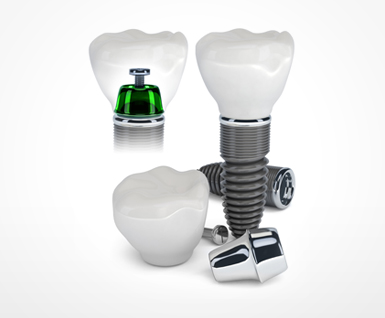-

Opening Hours
view our working time
-
Call us: +91 4936208777
+919562488777
Dental implants
If you are worried about missing teeth, dentures that are uncomfortable or don't want to have a nearby good tooth chipped to make a bridge , talk to our specialists to see if
dental implants are an option for you.
Dental implants are a popular and effective way to replace missing teeth and are designed to blend in with your other teeth. They are an excellent long-term option for
restoring your smile. Dental implants are made up of titanium that are compatible with the human body. They are titanium posts that are surgically placed in the upper or
lower jaw. The jawbone fuses with the titanium surface providing a strong anchorage for the dental prosthesis constructed over it. To receive an implant, you need to have
healthy gums and enough bone to support the implant.
Applications of Dental Implants
-

Dental implants can be used to replace a single tooth
-

Dental implants can be used as anchors to support a fixed bridge
-

Full arch dental implants with fixed bridges
-

Dental implants can provide stability for a complete denture, there by eliminating unsightly moving and clicking associated with dentures
Benefits of dental implants
The mouth is restored as closely as possible to its natural state.
By replacing the entire tooth, including the root, it is possible to replicate the function of natural teeth, with a strong, stable foundation that allows comfortable biting and chewing. In addition, nothing in the mouth looks, or feels artificial.
Dental implants are stronger and more durable than other restorative options (bridges and dentures)
Implants offer a permanent solution to tooth loss. Natural teeth absorb great amount of biting pressure – approximately 540 lbs/sq. inch. On the contrary, those who are wearing dentures can hardly absorb 50lbs/sq. inch. However, dental implants can withstand 450 lbs./sq. inch biting pressure without any problems, whatsoever. Implants if properly maintained can last a lifetime depending on the bone strength and other oral conditional of the patient.
Implants preserve the integrity of facial structures
By preventing the bone disintegration that would normally occur with the loss of teeth, the facial structures remain intact. This is particularly important when all of the teeth are missing, as the lower one-third of the face collapses if implants are not placed to preserve the bone.
Your smile is improved when replacement teeth look more like natural teeth
Even when only one tooth is missing, long term esthetics are usually much better with an implant supported replacement tooth than with a traditional tooth supported bridge.This is particularly important in the front of your mouth, where preventing a visible bone defect is critical for natural appearance.
Adjacent teeth are not compromised to replace missing teeth
Tooth replacement with traditional tooth-supported bridges requires grinding down the teeth adjacent to the missing tooth/teeth, so that the bridge can be cemented onto them. This tooth structure can never be replaced and the long-term health of these teeth is compromised. Partial dentures have clasps that hook onto adjacent teeth, putting pressure on them as the partial rocks back and forth. Eventually these teeth can loosen and come out as a result of this pressure. Replacing missing teeth with implant supported crowns/bridges does not involve the adjacent natural teeth, so they are not compromised, or damaged.
Overall quality of life is enhanced with replacement teeth that look, feel and function like natural teeth
With implant supported replacement teeth, the appearance of the smile is more natural and the teeth function more like natural teeth. The result is increased comfort and confidence when smiling, speaking and eating. It improves your speech by eliminating or reducing the "fullness" of full or partial dentures. Chewing can be difficult with dentures. Dental implants let you eat without worries.
Convenient oral hygiene
It is much easier to care for an implant supported crown, which can be cleaned like a natural tooth. In comparison, a tooth supported bridge requires the use of a floss threader for proper cleaning. It is also more convenient to clean a full set of implant supported replacement teeth than a traditional denture.
Improved appearance
Since implants preserve bone, preventing deterioration of the facial structures, appearance is improved. Collapse of the lower one-third of the face caused by complete tooth loss can be visually corrected and the remaining bone preserved. The appearance of wrinkles around the mouth caused by posterior bite collapse, or complete facial structure collapse is virtually eliminated.
Restored self-esteem and renewed self-confidence
Many of the people who now enjoy the benefits of implant supported replacement teeth state that their self esteem and self confidence have been restored as a result of improved appearance, function, comfort, and health.
Types of Dental Implants based on procedure
There are mainly two types of implant procedures
- Conventional Dental Implants
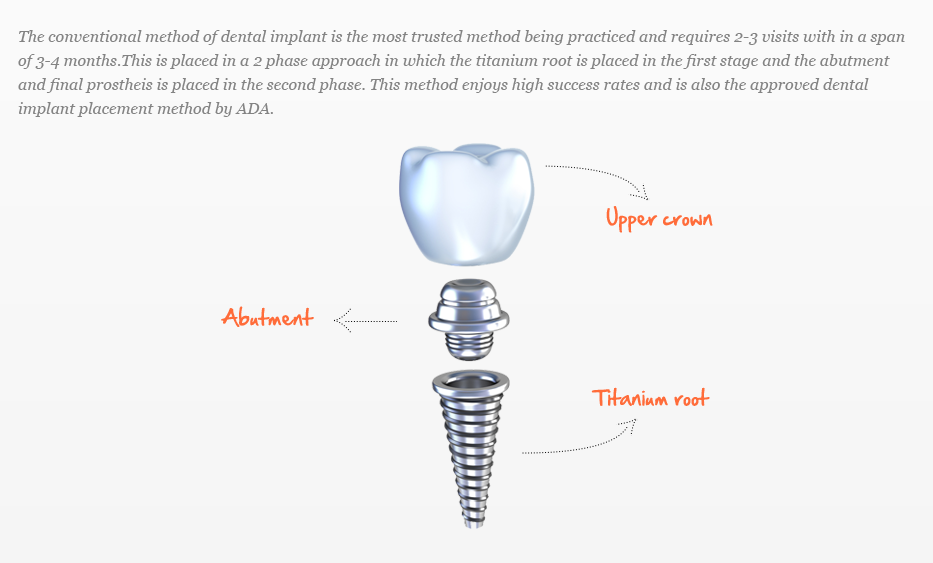
Below outlines the various phases involved in a conventional 2 step
Phase1
First evaluation and x-rayA OPG(Panoramic) x-ray is taken and oral examination is carried out to determine implant site and bone conditions. If required a CT scan is suggested if more detailed analysis is required.
Implant site preparationThe gum tissue is opened to expose the bone area where the implant will be placed. In some cases, depending on the patient's jaw bone anatomy, a sinus lift or a dental bone graft might be needed as well. Once healthy bone material has been established, the implant is ready to be put into place.
Placing the ImplantAfter the bone has been prepared, the implant is embedded and the tissue is sutured. A surgical cover screw is inserted into the top if the implant to prevent bone and tissue to grow inside the implant. A temporaryprosthesis is provided covering the dental implants.
Healing Process - OsseointegrationThe implant is left to integrate and heal with the jaw bone. The sutures are typically removed seven to fourteen days after surgery. The implant remains undisturbed for approximately 2-3 months and Osseointegration occurs during this period and the implant gets usually covered by gum tissues. A soft diet is recommended during the first 4 to 6 weeks.
Phase2
Uncovering implantsThe implants are uncovered by a minor surgical procedure and they are checked for Osseointegration.
Attaching the Abutment or metal bar/ballIf the implant is found to be of good bonding with the jaw bone, a special abutment or metal bar/ball is attached to the implant. If crowns or bridges are opted, an abutment is placed and this provides the support for the new crown or bridge. If overdentures are opted, the metal bar/ball is placed and the clip is used to securely retend the set of new overdentures. An full mouth X-ray is taken for its correctness.
Placing the Crown/Bridge or OverdentureAfter impressions are taken, the crown/bridge or overdenture is made. If crowns or bridges are opted, it is then fixed over the post and cemented or screwed on.If overdentures are opted, they are simply snapped onto the metal bars or balls.

- Immediate loading dental implants( Single piece Dental Implants)
Immediate loading implants or single piece dental implants is the case whereby the prosthetics or false teeth are placed onto the dental implant posts during the same phase after placement of the implants. With an immediate loaded dental implants procedure, phase 1 and 2 are done during the same phase. This means that a patient has new teeth in place during the same trip the implant posts in placed. Immediate load implants enables immediate function of teeth.
Parts of a single piece dental implant system
Latest implants systems such as the KOS (King of Singlepiece), the BCS (Basal Cortical Screw) and the BOI (Basal Osseo Integrated) implants are the recent introductions into the world of dental implants which are extremely predictable, simple and highly economical. These implants also present with a unique opportunity where they can be splinted to adjacent teeth unlike the previous ones (delayed loading) where this splinting could not be done. It is to be kept in mind that KOS Single piece implants are not indicated in all cases & they are to be used only in cases where there is good D1 / D2 bone.
Comparison of Conventional and Immediate loading Dental Implants
While traditional implant surgery uses a “two stage placement” that takes the surgery to complete in six months, immediate loading or “same day loading” allows completing the procedure the same day. Conventional dental implants require the gums and bones to heal before a crown could be fixed on the implant. The main disadvantage of this procedure is definitely the waiting time during which the patient has to live with no teeth. Sometimes temporary crowns are adjusted before actual teeth could be placed but these are quite uncomfortable and appear to be very unappealing. But those who decide to go for immediate loading dental implants also have to fulfill some minimum requirements in order to make the procedure successful.
If the implant does not attach with the bone correctly, the procedure will ultimately fail.If the tooth is located in a place where a lot of force will be applied afterwards, the chances of implant survival will lessen to a great extent. Another reason for not adopting this procedure could be its high cost as compared to traditional dental implants. This latest technique calls for an expenditure of up to $2500 depending on the experience of your dentist and the number of implants you want. This is a bit expensive for a lot of people out there who would prefer to live with damaged teeth than to pay such a huge amount for a procedure the success of which could not be predicted.
However, if you qualify for immediate load implants, there are many advantages as well thatyou can consider. First of all, it reduces the healing time and allows the patients to carry on with everyday functionality required of their teeth. There is no need to tolerate the inconvenience of temporary crowns while the bone is healing. Since the patient requires only one visit to have the procedure performed, there is a less amount of anxiety and stress involved.
n case the implant fails to integrate, you can opt for another surgery. However, this option will cost you double than a traditional dental implant. If you can afford these disadvantages, the procedure has a lot of potential for you. The procedure has been seen to be the most successful for single tooth restoration.
The research on the success and long-term effectiveness of immediate load dental implants is still underway. However, most believe that the success rate of both procedures is almost similar provided that nothing goes wrong during the treatment. The procedure has more value when the patient is in need of emergency treatment for lost teeth. People are becoming more and more familiar with this new technique with the passage of time and its popularity is increasing with the number of success stories.
- Single Tooth Implant
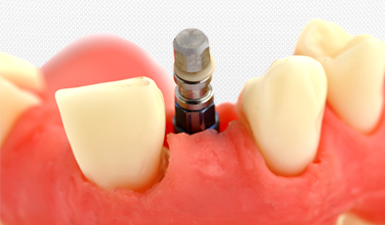
Single-tooth implants can be used in people who are missing one or more teeth. An implant is surgically placed in an opening that is made by your dentist in the jawbone.After the implant integrates (attaches) to your bone, it acts as a new "root" for the crown that will be replacing your missing tooth. A crown (cap), which is made to look like a natural tooth, is attached to the implant and fills the space left in the mouth by the missing tooth. For this procedure to work, there must be enough bone in the jaw, and the bone has to be strong enough to hold and support the implant. If there is not enough bone, be may need to be added with a procedure called bone augmentation. In addition, natural teeth and supporting tissues near where the implant will be placed must be in good health.
Step by step procedure of single Implant Placement
-

Step1
-

Step2
-

Step3
-

Step4
-
- Multiple Dental Tooth Implants
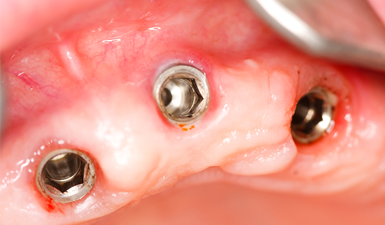
Mulitple Dental Tooth Implants are done when replacing several gaps if teeth. If there are missing gaps together, dental tooth implants with a bridge may be done. An implant bridge will consist of the crowns on dental tooth implants as well as pontic crowns. A pontic crown is a dental crown that is joined together to the anchor crowns on the dental tooth implants in forming a dental bridge.
If there are missing gaps in separate locations, then separate single dental tooth implants with dental crown or a combination of dental tooth implants with dental crown and dental bridges may be done in replacing missing gaps.
Step by step procedure of single Implant Placement
-
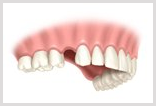
Step1
-
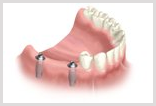
Step2
-
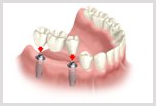
Step3
-
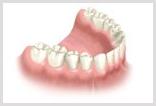
Step4
-
- Implant Supported Dentures
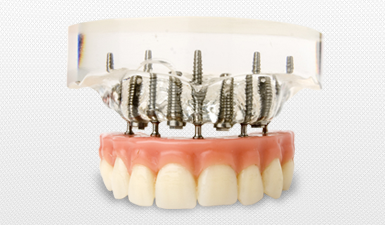
An implant-supported denture is a type of over denture that is supported by and attached to implants. A regular denture rests on the gums, and is not supported by implants.
An implant-supported denture is used when a person doesn't have any teeth in the jaw, but has enough bone in the jaw to support implants. An implant-supported denture has special attachments that snap onto attachments on the implants. Implant-supported dentures usually are made for the lower jaw because regular dentures tend to be less stable there. Usually, a regular denture made to fit an upper jaw is quite stable on its own and doesn't need the extra support offered by implants. However, you can receive an implant-supported denture in either the upper or lower jaw.
- Full Mouth Implants
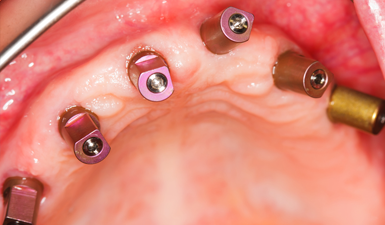
Traditionally, an implant placed into your bone supports a single crown and this is know as a “single tooth implant”. However, if you have several missing teeth, you do not necessarily need an implant for every missing tooth: one implant can support several teeth via a bridge or denture. The number of implants required depends on the volume and density of bone tissue available at each implant site.
n the case of full-mouth reconstructions, where an arch of several teeth needs to be supported in either the upper or lower jaw, a minimum of five to six implants in each jaw would be required. The exact number of implants needed would depend on the individual case. This type of treatment is not for everybody and any surgical procedure carries risks.
With dental implants you can eat the foods you want and speak with complete confidence. With dentures, eating hard foods such as an apple can be a problem: either the dentures come loose or patients cannot withstand the hard biting forces as they cause pain in the gums. Dentures can be supported by implants, which will greatly improve function, enabling patients to eat the foods they want with complete confidence and not having to worry about pain, or loose dentures falling out.
Step by step procedure of Implant Supported Full Mouth Bridge Placement
-
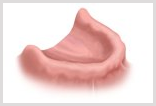
Step1
-
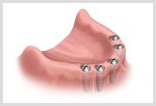
Step2
-
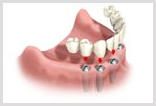
Step3
-
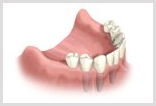
Step4
-
- Bone Grafting
Bone loss (or bone resorption) often occurs when teeth have been lost but not replaced, with age, or in people who have worn dentures for some time. When resorption has excessively reduced the jawbone, dental implants cannot be placed as there is not enough good-quality bone material for the implant to anchor to. In these cases, the bone can be rebuilt through modern bone grafting techniques. Bone grafts can build up or fill in jawbone defects allowing the successful placement of dental implants. Bone grafting is also used to help fusion between vertebrae, correct deformities, or provide structural support for fractures of the spine. In addition to fracture repair , bone grafting is used to repair defects in bone caused by congenital disorders, traumatic injury, or surgery for bone cancer. Bone grafts are also used for facial or cranial reconstruction.
- Sinus Lifting
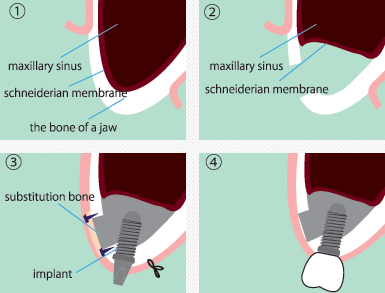
sinus lift is a surgery that will add bone to your upper jaw and in the area of your premolars and your molars. A sinus lift is sometimes referred to as sinus augmentation. Bone will be added in between your jaw and your maxillary sinuses. They can be on either sides of your nose. In order to make room for the bone, the sinus membrane may be moved upward or lifted.
A sinus lift is performed when there is not enough bone in the upper jaw or the sinuses to hold dental implants. Here are some of the reasons sinus lifts are used.
People who have lost teeth in their upper jaw like the back teeth molars may not have enough bone for implants to be placed. Bone loss may have happened because of periodontal gum disease Tooth loss may have led to bone loss because when teeth are gone, bone starts to get reabsorbed back into the body. If teeth have been missing for a long time then there may not be enough bone left for implants The maxillary sinus could be too close to the upper jaw for the placement of implants. The size and the shape of the sinuses will vary among individuals.
Types of Dental Implants
Success rate of Dental Implants
Dental implants are extremely successful as many patients will testify to. The success rate is, on average, around 90 to 95% although figures vary slightly depending on which
part of the mouth is treated.
The front part of the lower jaw enjoys the highest rates of success, often reaching 98%. This figure drops slightly for other parts of the mouth.
Implants in the front part of the upper jaw enjoy 90 to 95% success rates.
The back part of the mouth in both the upper and lower jaw has the lowest rates of success but these are still high at 85 to 95%.
Disadvantages of Dental Implants
There are some aspects of dental implant treatment that you may regard as negatives. The following list is of some things you may want to consider before undertaking thesurgery.
A surgical procedure is required
It is unlikely that your dental implant treatment will require you to go under a general anaesthetic, but you will need to have a local anaesthetic and the implant is a surgical procedure. For some people, this is enough to put them off the treatment altogether! There are some tooth replacement treatments that do not require any surgery, and if you are particularly averse to it these might be better options for you.
The cost can be excessive for some people
Although the cost of dental implants varies greatly, it can be higher than £2000 per tooth. If you need a whole mouth of teeth replaced this can be a very expensive option. There are however different ways to get around this: do your research carefully, because there will be dentists who are just as good but charge less. Look for patient testimonials. You could also arrange a loan, a payment scheme, or with plenty of research have your implants fitted abroad.
You may need a Bone Graft
If you have worn dentures for years and are tired of the issues associated with them you may have your heart set on dental implants. Unfortunately, you may be told on assessment that you do not have enough bone to support dental implants. In some cases a bone graft may be the only option. This might sound scary but it is quite common for patients having dental implants and your dentist should be able to fully explain your options with the procedure. You could also ask your dentist if you are a suitable candidate for mini implants.
There is a 5% chance that the implant will fail to bond with the bone
It is possible that your body will reject the implant and the bone tissue will fail to bond with the roughened titanium surface of the implant. If this is the case your dentist may remove the implant, let the site heal, and try again. If this doesn’t work you may have to have a bridge or denture instead



